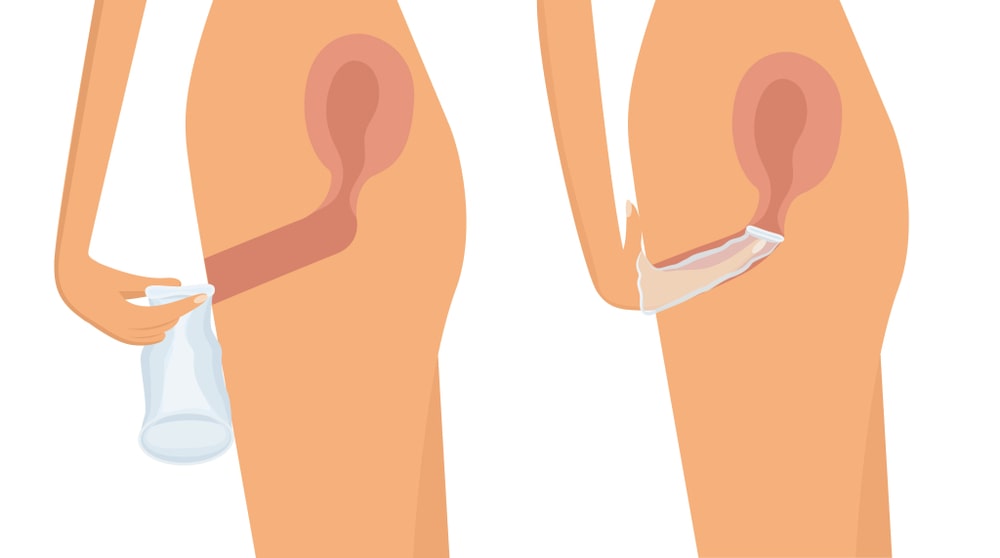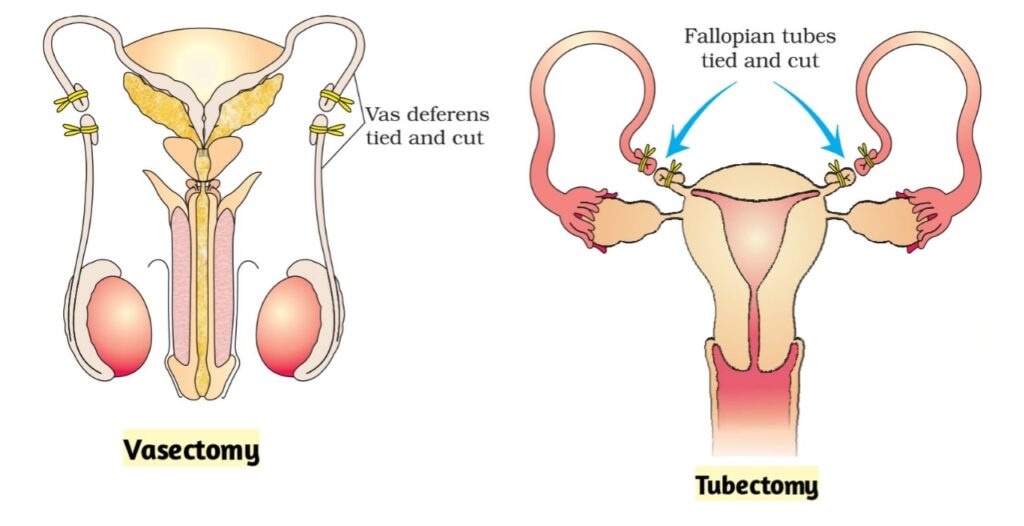According to the World Health Organisation (WHO), reproductive health means total well-being in all aspects of reproduction, i.e., physical, emotional, behavioral, and social. Therefore, a society with people having physically and functionally normal reproductive organs and normal emotional and behavioral interactions among them in all sex-related aspects might be called reproductively healthy.
Table of Contents
Problem and Strategies
India was amongst the first countries in the world to initiate action plans and programs at a national level to attain total reproductive health as a social goal. These programs called ‘family planning’ were initiated in 1951 and were periodically assessed over the past decades. Improved programs covering wider reproduction-related areas are currently in operation under the popular name ‘Reproductive and Child Health Care (RCH) programs’. Creating awareness among people about various reproduction-related aspects and providing facilities and support for building up a reproductively healthy society are the major tasks under these programs.
With the help of audio-visual and print-media governmental and non-governmental agencies have taken various steps to create awareness among the people about reproduction-related aspects. Parents, other close relatives, teachers, and friends, also have a major role in the dissemination of the above information. The introduction of sex education (“Reproductive Health”) in schools should also be encouraged to provide the right information to the young to discourage children from believing in myths and having misconceptions about sex-related aspects. Proper information about reproductive organs, adolescence and related changes, safe and hygienic sexual practices, sexually transmitted diseases (STD), AIDS, etc., would help people, especially those in the adolescent age group to lead a reproductively healthy life. Educating people, especially fertile couples and those in the marriageable age group, about available birth control options, care of pregnant mothers, post-natal care of the mother and child, the importance of breastfeeding, equal opportunities for the male and the female child, etc., would address the importance of bringing up socially conscious healthy families of the desired size. Awareness of problems due to uncontrolled population growth, social evils like sex abuse and sex-related crimes, etc., need to be created to enable people to think and take up necessary steps to prevent them and thereby build up a socially responsible and healthy society.
Successful implementation of various action plans to attain reproductive health requires strong infrastructural facilities, professional expertise, and material support. These are essential to provide medical assistance and care to people in reproduction-related problems like pregnancy, delivery, STDs, abortions, contraception, menstrual problems, infertility, etc. Implementation of better techniques and new strategies from time to time are also required to provide more efficient care and assistance to people. Statutory ban on amniocentesis (a fetal sex determination test based on the chromosomal pattern in the amniotic fluid surrounding the developing embryo) for sex-determination to legally check increasing female foeticides, massive child immunization, etc., are some programs that merit mention in this connection.
Population explosion and Birth control
In the last century, an all-around development in various fields significantly improved the quality of life of the people. However, increased health facilities along with better living conditions had an explosive impact on the growth of the population. The world population which was around 2 billion (2000 million) in 1900 rocketed to about 6 billion by 2000. A similar trend was observed in India too. Our population which was approximately 350 million at the time of our independence reached close to the billion mark by 2000 and crossed 1 billion in May 2000. That means every sixth person in the world is an Indian. A rapid decline in death rate, the maternal mortality rate (MMR), and infant mortality rate (IMR) as well as an increase in the number of people in reproducible age are probable reasons for this. Through our RCH programs, though we could bring down the population growth rate, it was only marginal. According to the 2001 census report, the population growth rate was still around 1.7 percent, i.e., 17/1000/year, a rate at which our population could double in 33 years. Such an alarming growth rate could lead to an absolute scarcity of even the basic requirements, i.e., food, shelter, and clothing, despite significant progress made in those areas. Therefore, the government was forced to take up serious measures to check this population growth rate.
The most important step to overcome this problem is to motivate smaller families by using various contraceptive methods. You might have seen advertisements in the media as well as posters/bills, etc., showing a happy couple with two children with a slogan Hum Do Hamare Do (we two, our two). Many couples, mostly the young, urban, working ones have even adopted a ‘one child norm’. Statutory raising of marriageable age of the female to 18 years and that of males to 21 years, and incentives given to couples with small families are two of the other measures taken to tackle this problem. Let us describe some of the commonly used contraceptive methods, which help prevent unwanted pregnancies.
An ideal contraceptive should be user-friendly, easily available, effective, and reversible with no or least side effects. It also should in no way interfere with the sexual drive, desire, and/or the sexual act of the user. A wide range of contraceptive methods is presently available which could be broadly grouped into the following categories, namely Natural/Traditional, Barrier, IUDs, Oral contraceptives, Injectables, Implants, and Surgical methods.
Natural methods work on the principle of avoiding chances of ovum and sperms meeting. Periodic abstinence is one such method in which the couples avoid or abstain from coitus from day 10 to 17 of the menstrual cycle when ovulation could be expected. As chances of fertilization are very high during this period, it is called the fertile period. Therefore, by abstaining from coitus during this period, conception could be prevented. Withdrawal or coitus interruptus is another method in which the male partner withdraws his penis from the vagina just before ejaculation to avoid insemination. The lactational amenorrhea (absence of menstruation) method is based on the fact that ovulation and therefore the cycle does not occur during the period of intense lactation following parturition. Therefore, as long as the mother breastfeeds the child fully, the chances of conception are almost nil. However, this method has been reported to be effective only up to a maximum period of six months following parturition. As no medicines or devices are used in these methods, side effects are almost nil. Chances of failure, though, of this method are also high.


In barrier methods, ovum and sperms are prevented from physically meeting with the help of barriers. Such methods are available for both males and females. Condoms (Figure 1.1 a, b) are barriers made of thin rubber/ latex sheath that are used to cover the penis in the male or vagina and cervix in the female, just before coitus so that the ejaculated semen would not enter into the female reproductive tract. This can prevent conception. ‘Nirodh’ is a popular brand of condoms for males. The use of condoms has increased in recent years due to the additional benefit of protecting the user from contracting STDs and AIDS. Both the male and the female condoms are disposable, can be self-inserted, and thereby gives privacy to the user. Diaphragms, cervical caps, and vaults are also barriers made of rubber that are inserted into the female reproductive tract to cover the cervix during coitus. They prevent conception by blocking the entry of sperms through the cervix. They are reusable. Spermicidal creams, jellies, and foams are usually used along with these barriers to increase their contraceptive efficiency.
Another effective and popular method is the use of Intra-Uterine Devices (IUDs). These devices are inserted by doctors or expert nurses in the uterus through the vagina. These Intra Uterine Devices are presently available as the non-medicated IUDs (e.g., Lippes loop), copper releasing IUDs (CuT, Cu7, Multiload 375), and the hormone-releasing IUDs (Progestasert, LNG-20) (Figure 1.2). IUDs increase phagocytosis of sperms within the uterus and the Cu ions released suppress sperm motility and the fertilizing capacity of sperms. The hormone-releasing IUDs, in addition, make the uterus unsuitable for implantation and the cervix hostile to the sperms. IUDs are ideal contraceptives for females who want to delay pregnancy and/or space children. It is one of the most widely accepted methods of contraception in India.

Oral administration of small doses of either progestogens or progestogen–estrogen combinations is another contraceptive method used by females. They are used in the form of tablets and hence are popularly called pills. Pills have to be taken daily for a period of 21 days starting preferably within the first five days of the menstrual cycle. After a gap of 7 days (during which menstruation occurs) it has to be repeated in the same pattern till the female desires to prevent conception. They inhibit ovulation and implantation as well as alter the quality of cervical mucus to prevent/ retard entry of sperms. Pills are very effective with lesser side effects and are well accepted by females. Saheli –the new oral contraceptive for females contains a non-steroidal preparation. It is a ‘once a week’ pill with very few side effects and high contraceptive value.
Progestogens alone or in combination with estrogen can also be used by females as injections or implants under the skin. Their mode of action is similar to that of pills and their effective periods are much longer. Administration of progestogens or progestogen-estrogen combinations or IUDs within 72 hours of coitus has been found to be very effective as emergency contraceptives as they could be used to avoid possible pregnancy due to rape or casual unprotected intercourse.
Surgical methods, also called sterilization, are generally advised for the male/female partner as a terminal method to prevent any more pregnancies. Surgical intervention blocks gamete transport and thereby prevents conception. Sterilization procedure in the male is called ‘vasectomy’ and that in the female, ‘tubectomy’. In a vasectomy, a small part of the vas deferens is removed or tied up through a small incision on the scrotum (Figure 1.3a) whereas, in tubectomy, a small part of the fallopian tube is removed (Figure 1.3b) or tied up through a small incision in the abdomen or through the vagina. These techniques are highly effective but their reversibility is very poor.

It needs to be emphasized that the selection of a suitable contraceptive method and its use should always be undertaken in consultation with qualified medical professionals. One must also remember that contraceptives are not regular requirements for the maintenance of reproductive health. They are practiced against a natural reproductive event, i.e., conception/pregnancy. One is forced to use these methods either to prevent pregnancy or to delay or space pregnancy due to personal reasons. No doubt, the widespread use of these methods has a significant role in checking the uncontrolled growth of the population. However, their possible ill-effects like nausea, abdominal pain, breakthrough bleeding, irregular menstrual bleeding, or even breast cancer, though not very significant, should not be ignored.
Medical termination of pregnancy (MTP)
Intentional or voluntary termination of pregnancy before full term is called medical termination of pregnancy (MTP) or induced abortion. Nearly 45 to 50 million MTPs are performed in a year all over the world which accounts for 1/5th of the total number of conceived pregnancies in a year. MTP has a significant role in decreasing the population though it is not meant for that purpose. Whether to accept /legalize MTP or not is being debated in many countries due to the emotional, ethical, religious, and social issues involved in it. The government of India legalized MTP in 1971 with some strict conditions to avoid its misuse. Such restrictions are all the more important to check indiscriminate and illegal female foeticides which are reported to be high in India.
Why MTP?
To get rid of unwanted pregnancies either due to casual unprotected intercourse or failure of the contraceptive used during coitus or rapes. MTPs are also essential in certain cases where the continuation of the pregnancy could be harmful or even fatal either to the mother or to the fetus or both.
MTPs are considered relatively safe during the first trimester, i.e., up to 12 weeks of pregnancy. Second-trimester abortions are much riskier. One disturbing trend observed is that a majority of the MTPs are performed illegally by unqualified quacks which are not only unsafe but could be fatal too. Another dangerous trend is the misuse of amniocentesis to determine the sex of the unborn child. Frequently, if the fetus is found to be female, it is followed by MTP- this is totally against what is legal. Such practices should be avoided because these are dangerous both for the young mother and the fetus. Effective counseling on the need to avoid unprotected coitus and the risk factors involved in illegal abortions as well as providing more health care facilities could reverse the mentioned unhealthy trend.
Infertility
A discussion on reproductive health is incomplete without a mention of infertility. A large number of couples all over the world including India are infertile, i.e., they are unable to produce children in spite of unprotected sexual cohabitation. The reasons for this could be many–physical, congenital, diseases, drugs, immunological, or even psychological.
In India, often the female is blamed for the couple being childless, but more often than not, the problem lies in the male partner. Specialized health care units (infertility clinics, etc.) could help in the diagnosis and corrective treatment of some of these disorders and enable these couples to have children. However, where such corrections are not possible, the couples could be assisted to have children through certain special techniques commonly known as assisted reproductive technologies (ART).
In vitro fertilization (IVF–fertilization outside the body in almost similar conditions as that in the body) followed by embryo transfer (ET) is one such method. In this method, popularly known as the test-tube baby program, ova from the wife/donor (female) and sperms from the husband/donor (male) are collected and are induced to form zygote under simulated conditions in the laboratory. The zygote or early embryos (with up to 8 blastomeres) could then be transferred into the fallopian tube (ZIFT–zygote intrafallopian transfer) and embryos with more than 8 blastomeres, into the uterus (IUT – intrauterine transfer), to complete their further development. Embryos formed by in-vivo fertilization (fusion of gametes within the female) also could be used for such transfer to assist those females who cannot conceive.
Transfer of an ovum collected from a donor into the fallopian tube (GIFT – gamete intrafallopian transfer) of another female who cannot produce one, but can provide a suitable environment for fertilization and further development is another method attempted. Intracytoplasmic sperm injection (ICSI) is another specialized procedure to form an embryo in the laboratory in which a sperm is directly injected into the ovum. Infertility cases either due to the inability of the male partner to inseminate the female or due to very low sperm counts in the ejaculates could be corrected by artificial insemination (AI) technique. In this technique, the semen collected either from the husband or a healthy donor is artificially introduced either into the vagina or into the uterus (IUI – intra-uterine insemination) of the female.
Though options are many, all these techniques require extremely high precision handling by specialized professionals and expensive instrumentation. Therefore, these facilities are presently available only in very few centers in the country. Their benefits are affordable to only a limited number of people. Emotional, religious, and social factors are also deterrents in the adoption of these methods. Since the ultimate aim of all these procedures is to have children, in India we have so many orphaned and destitute children, who would probably not survive till maturity, unless taken care of. Our laws permit legal adoption and it is as yet, one of the best methods for couples looking for parenthood.
Make sure you also check our other amazing Article on: Genetics
